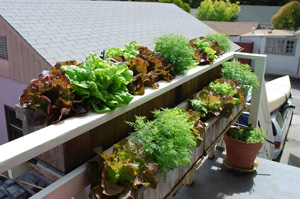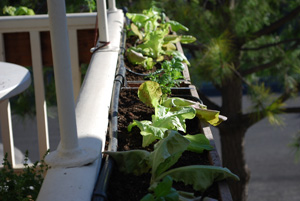Moderating Container Garden
Temperature
Container garden temperature can be a big issue on balcony farms.

|
|
Allowing Me to Grow Salads in High Summer © Steve Masley…Click IMAGE to Enlarge |
Containers are extreme environments for plants. Daytime temperatures are hotter, and nighttime temperatures are colder than temperatures for plants grown in the ground, because the surrounding soil moderates temperature extremes.
It takes longer for soil to warm up during the day, and longer for it to cool off at night.
Plants in pots heat up sooner, and cool off more quickly, than plants in the ground. Smart container gardeners can use this to their advantage.
Siting Your Container Vegetable Garden
Where you site your container vegetable garden has the biggest effect on container garden temperature. A sunny, south-facing deck or balcony can be 25-30° hotter than a north-facing deck.

|
|
© Steve Masley…Click IMAGE to Enlarge |
The material and color of the deck is important, too.
Wood will heat up, but it won’t get as hot as ceramic tiles or stucco walls, which collect and radiate heat. Lighter colors reflect light, so less heat is absorbed. Darker colors absorb light and hold heat.
Finally, container size, material, and placement can influence container garden temperature.
If you have decks or terraces on different sides of your apartment or house, you can put heat-loving container vegetables in the hottest spot, and vegetables that do better under cooler conditions on the north or east side, where it’s not as hot.
Most balcony farmers don’t have multiple options. There’s only one deck or terrace, and that’s where your vegetable container garden has to go. When this is the case, here are a few simple tricks to moderate container garden temperatures.
Learn to Read and Use Microclimates
I started balcony farming when I noticed that the shadow of the roof line fell across our back deck railing on summer afternoons, so I could grow salads there all summer long, even in sunny California.
I re-enforced the deck rail and built cantilevered planters, to take advantage of the microclimate.
Make a practice of studying the way the light moves on your container garden every season of the year. Pay attention to the shadows of trees and buildings.
A shadow that just nicks your deck for a couple hours every afternoon could provide a cooler, partially shaded microclimate for leafy vegetables that wouldn’t survive five feet away, where the sun shines unbroken all day.
Tip: The path of the full moon is the path of the sun six months later. Go outside on the full moon in December, and study how the shadows of nearby trees and buildings move across your balcony, deck, or garden. The sun will cast the same shadows in June, six months later.
This gives you a way to garden in the middle of winter…or at least, plan and scheme about gardening.
Cooling Container Gardens
The easiest way to cool a container garden, is to keep it from getting too hot in the first place. During heat waves, Shade Net is the container gardener’s best friend. Especially if the heat comes right after transplanting, before the plants have established root systems.
There are several ways to moderate temperatures when growing vegetables in containers. To keep container gardens cooler:
- Use light-colored pots that reflect sunlight and absorb less heat.
- Use a light-colored mulch to hold moisture and keep the soil surface cooler.
- Group plant containers together. Individual pots are exposed to sun and wind on multiple sides. Pots in groups shade each other, and shield each other from the wind.
- Use shade net to filter the hot summer sun. Shade net is available in mesh sizes that reduce incoming sun by 33% and 50%. The 33% mesh is fine for most container gardens during the hottest part of the summer. Use 50% mesh in very hot climates or hot exposures.
- Water frequently in hot weather. Evaporation cools container gardens.
- Set potted vegetables in shallow trays of gravel. Water that drains through the pots evaporates slowly from the trays, cooling the surrounding area and increasing humidity around your container garden vegetables.
Holding Heat in Container Gardens
To keep Container Gardens warmer:
- Choose dark-colored pots or window boxes. Dark materials absorb heat.
- Use dark-colored mulches to warm the soil surface in the pots.
- Cover the plants at night, or move them under cover of a carport or awning.
- Place plants against a sunny wall.
- Fill some black plastic containers with water, cover, and allow the sun to heat them up during the day. Place them around heat-loving plants. The containers will give up heat slowly through the night, moderating nighttime lows.
Top of Container Garden Temperature
Selecting Containers
|
Choosing Container Vegetables
|
Drainage
Watering
|
Fertilizing
|
Potted Vegetables
Salad Tables
|
SaladScapes
Copyright © 2009-2025, by Steve Masley, Grow-it-Organically.com
All rights reserved
HOME | About Us | Contact Us | Privacy
New! Comments
Have a question or comment about what you just read? Leave me a comment in the box below.